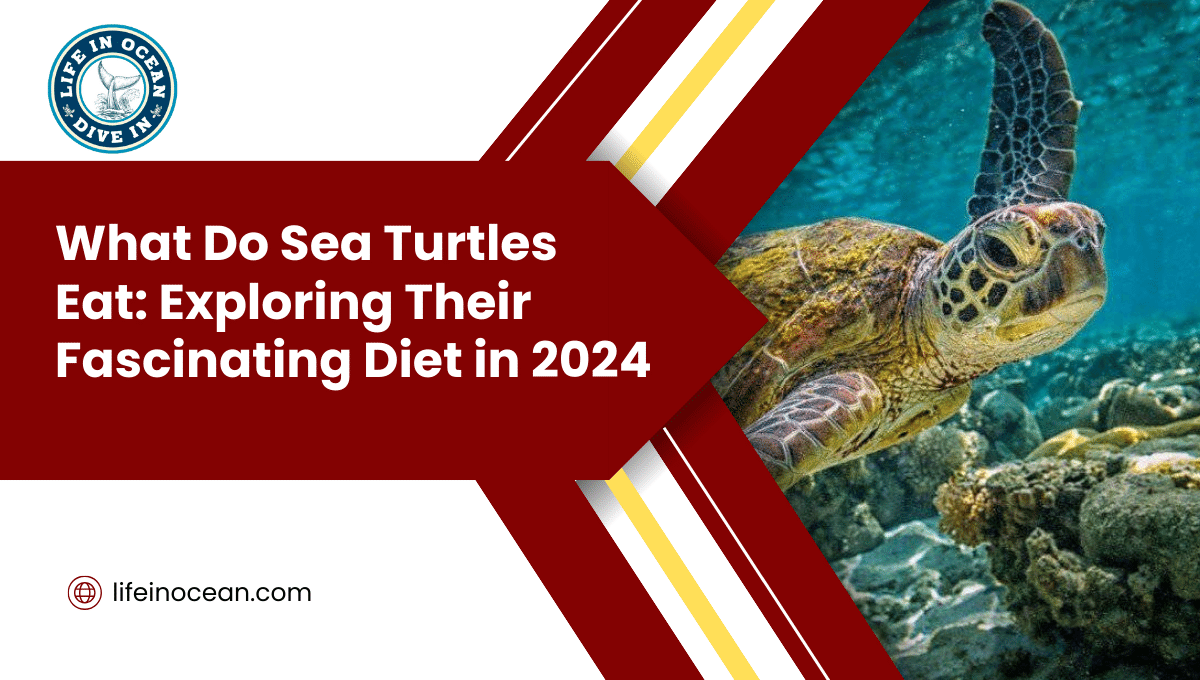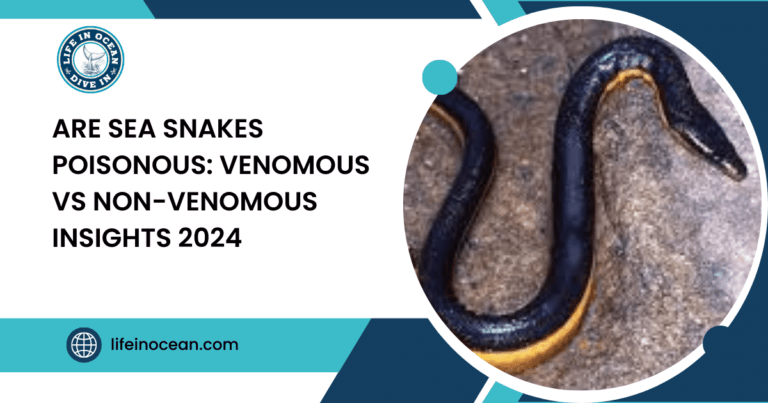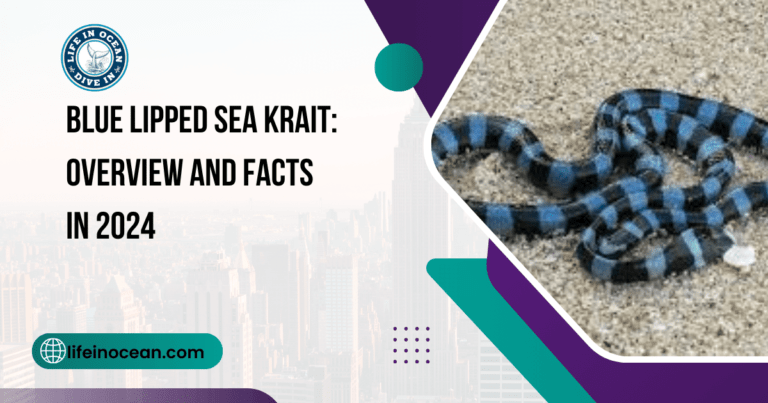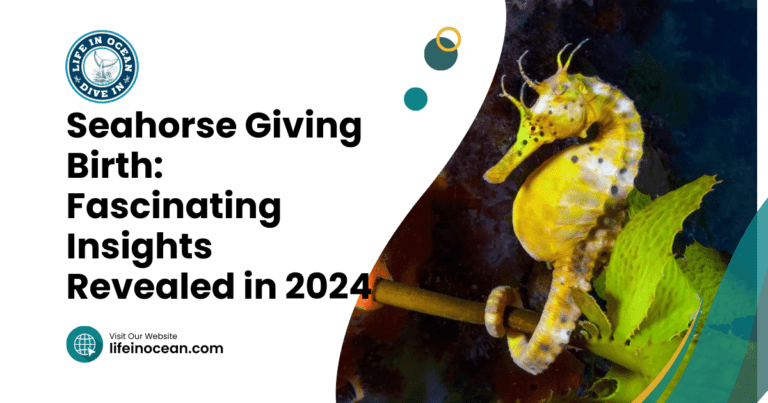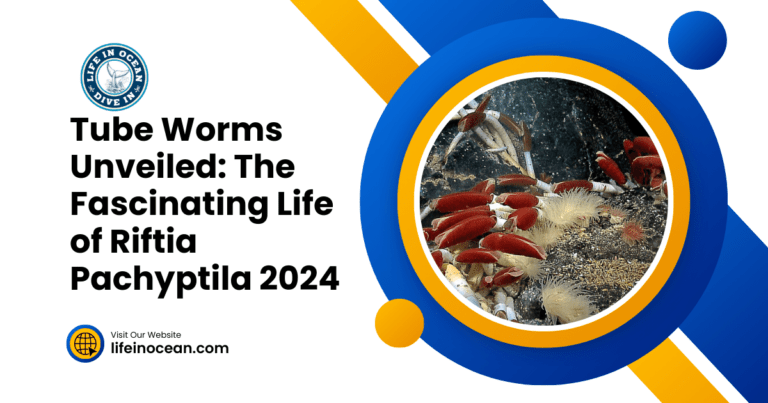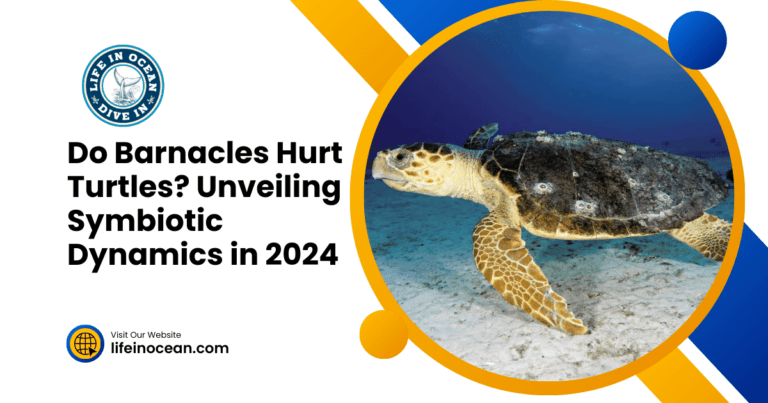Sea turtles have a diverse diet, ranging from plants to meat. Understanding what do sea turtles eat is vital for their conservation and protection. Their meal choices vary by species and age, with some being resident herbivores while others are carnivorous nomads. For instance, green sea turtles feast on seagrass and algae, enriching the ocean’s biodiversity, whereas leatherback sea turtles grind through jellyfish like underwater vacuum cleaners.
This variety in diet showcases the intricate relationship between these creatures and the organisms inside their watery world. Exploring this contrast in dietary preferences can help us comprehend and care for these fascinating marine residents better.
Table of Contents
What Do Sea Turtles Eat?
Marine Plants
Sea turtles have a diverse diet that includes marine plants. They feed on seaweed, algae, and seagrass found in their marine habitats. These plants provide essential nutrients and minerals for the turtles’ growth and development.
Sea turtles primarily feed on marine invertebrates, such as crabs, shrimp, sea urchins, and mollusks. These invertebrates are an important source of protein for the turtles’ diet.
Fish and Crustaceans
Some sea turtle species also consume fish and crustaceans. For example, the loggerhead turtle is known to eat fish like anchovies and menhaden. The hawksbill turtle feeds on sponges along with other small organisms like jellyfish.
Why do sea turtles eat plastic?

Mistaking Plastic for Food
Sea turtles often mistake plastic debris for food because it looks like jellyfish, one of their main sources of nutrition. Imagine if you were really hungry and someone placed a real apple next to a fake one that looked exactly the same. You might accidentally eat the fake apple, thinking it was real.
Ingesting plastic can have severe consequences for sea turtles. The plastic can cause blockages in their digestive system or make them feel full when they’re actually not getting any nutrients. It’s like trying to eat something that looks delicious but is actually made of paper – it won’t give your body the energy and nutrients it needs.
Threat to Survival
Plastic pollution poses a significant threat to the survival of sea turtle populations. Just like how eating unhealthy food can make people sick, consuming plastic makes sea turtles ill too.
The Specific Diet of Each Sea Turtle Species
Dietary Preferences
Each sea turtle species has its own specific dietary preferences. Understanding the specific diet of each species is crucial for their survival and well-being. For instance, green sea turtles are primarily herbivores, consuming seagrasses and algae, while leatherback sea turtles have a diet consisting mainly of jellyfish. This differentiation in diets among various sea turtle species is essential for conservation efforts and ecological balance.
Sea turtles play a vital role in marine ecosystems by maintaining the health of seagrass beds and controlling jellyfish populations. By knowing what each species eats, researchers can better understand how to protect these habitats and manage human activities that may negatively impact them. For example, if we know that loggerhead sea turtles feed on crabs, efforts can be made to conserve crab populations to ensure the availability of food for these turtles.
Research and Management
Differentiating between the diets of various sea turtle species
Green Turtle Diet
Herbivorous Diet
Green turtles, such as the green turtles, have a primarily herbivorous diet, which means they mainly eat plants. Their diet consists of seagrass and algae. These marine reptiles play a crucial role in maintaining healthy seagrass ecosystems by controlling the growth of seagrass beds through grazing.
They help prevent overgrowth by consuming large quantities of seagrasses, promoting the growth of new shoots and enhancing overall biodiversity within their habitat. This process is essential for the health and sustainability of both the seagrass beds and the species that depend on them.
Juvenile Consumption
In addition to their herbivorous diet, juvenile green turtles may also consume small invertebrates. While their primary food source remains seagrass and algae, young green turtles might occasionally feed on small animals like jellyfish or sponges until they transition to an exclusively herbivorous diet as adults.
Adult Sea Turtle Diet
Varied Diets
Adult sea turtles have varied diets depending on the species. Some adult sea turtles are omnivorous, consuming both plants and animals. Others are predominantly herbivorous or carnivorous.
Sea turtles such as the loggerhead and leatherback primarily consume a variety of invertebrates including crabs, jellyfish, and mollusks. These species can also feed on algae and seagrass, making them omnivores. On the other hand, green sea turtles are mainly herbivorous, feeding on seagrasses and algae. This diverse diet allows them to obtain essential nutrients from different sources.
Carnivorous vs Herbivorous
The hawksbill turtle is an example of a predominantly carnivorous species; they feed on sponges, cnidarians (such as jellyfish), and other invertebrates found in coral reefs.
Mouths & Jaws of Sea Turtles
Herbivorous Sea Turtles
Herbivorous sea turtles have specialized mouths with serrated jaws that allow them to graze on seagrass and algae. These types of sea turtles, like the green sea turtle, have beak-like jaws that help them tear through tough vegetation. They use their strong jaws to munch on underwater plants such as seagrasses and algae.
These creatures’ jaws, designed like scissors, enable them to easily slice through fibrous aquatic plants. For instance, the green sea turtle’s mouth structure is perfectly adapted for its vegetarian diet. They rely heavily on their powerful jaws to consume large amounts of seagrasses daily.
Carnivorous Sea Turtles
On the other hand, carnivorous sea turtles possess sharp beaks that aid in capturing prey such as jellyfish, tunicates, and shelled prey including horseshoe crabs and sea squirts.
Flatback Diet
Unique Eating Habits
Flatback turtles have unique eating habits compared to other sea turtle species. They primarily feed on soft-bodied invertebrates and jellyfish, making their diet distinct from that of other sea turtles. This unique diet sets them apart from their counterparts, as they rely less on vegetation and more on these specific types of prey.
Flatback turtles’ preference for soft-bodied invertebrates and jellyfish impacts their feeding behavior and habitat selection. Their specialized diet influences the areas where they forage for food, as they are drawn to locations abundant with their preferred prey. The availability of these food sources can significantly impact the population dynamics of flatback turtles, making it crucial to monitor changes in the abundance of their preferred foods.
Impact on Population Dynamics
The availability of flatbacks’ preferred food sources plays a critical role in shaping their population dynamics.
Hawksbill Diet
Specialized Diet
Hawksbill turtles have a unique and specialized diet, mainly consisting of sponges. Unlike other sea turtle species, hawksbills are known for their preference for sponges, which makes up the majority of their diet. This specialized feeding behavior sets them apart from other sea turtles and plays a crucial role in the marine ecosystem.
Their selective consumption of sponges is essential in maintaining the balance of marine life. By controlling sponge populations, hawksbill turtles indirectly contribute to the health and diversity of coral reef ecosystems. This demonstrates how each species within an ecosystem plays a vital role in its overall well-being.
Other Invertebrates
In addition to sponges, hawksbills also consume various other invertebrates, including jellyfish and sea anemones.
Kemp’s Ridley Diet
Opportunistic Feeders
Kemp’s ridley turtles are opportunistic feeders, meaning they eat a wide range of prey. They take advantage of whatever food is readily available in their environment. This adaptability helps them survive in different habitats and ecosystems.
They consume various prey items such as crabs, shrimp, fish, and even jellyfish. These marine creatures provide the necessary nutrients for the turtles to grow and thrive. For example, crabs offer a good source of protein, while jellyfish can be rich in energy-giving carbohydrates.
Role of Food Availability
The availability of food resources plays a crucial role in the survival of Kemp’s ridley turtles. Their feeding habits are greatly influenced by the abundance or scarcity of their prey in their habitat. When certain types of food are scarce, these turtles must adapt and find alternative sources to sustain themselves.
Leatherback Diet
Unique Diet
Leatherback turtles have a unique diet that sets them apart from other sea turtle species. Unlike some turtles, which are herbivorous and others which are carnivores, leatherbacks primarily feed on jellyfish. This makes their feeding habits quite distinctive.
The specialized adaptations of leatherback turtles enable them to consume large quantities of jellyfish. Their throat is lined with backward-pointing spines and their jaws have sharp-edged plates that help them swallow slippery prey like jellyfish without losing grip. These unique adaptations allow the leatherbacks to efficiently capture and ingest their preferred food source.
Impact of Jellyfish Populations
Changes in the population of jellyfish can significantly affect the foraging behavior of leatherback turtles. For example, if there’s a decline in jellyfish numbers due to factors such as pollution or overfishing, it could lead to challenges for leatherbacks in finding enough food.
Loggerhead Diet
Diverse Diet
Loggerhead turtles, like leatherbacks, have a diverse diet. They feed on various marine creatures such as crustaceans, mollusks, and fish. These turtles are not picky eaters; they enjoy a wide range of food.
They use their powerful jaws to consume hard-shelled prey. Their ability to crush the shells of their prey makes them effective hunters in the ocean. This characteristic sets them apart from other sea turtle species with different feeding habits.
Influence on Distribution
The abundance of their preferred food sources directly impacts the distribution patterns of loggerhead turtles. Areas with an ample supply of crustaceans and mollusks tend to attract more loggerheads compared to regions where these food sources are scarce.

For instance, when there is an abundant population of crabs along certain coastlines or within specific oceanic regions, loggerheads tend to frequent those areas due to the availability of their favored food source.
Olive Ridley Diet
Varied Diet
Olive ridley turtles have a varied diet that consists of different types of marine creatures. They feed on crustaceans, such as crabs and shrimp, which provide them with essential nutrients for their survival. They consume mollusks, including snails and clams, as part of their regular diet. Their diet also includes various species of fish, adding to the diversity of their food sources.
These turtles are known for engaging in mass nesting events called arribadas. During these arribadas, thousands of female olive ridleys come ashore to lay eggs simultaneously. The availability of food resources significantly affects the timing and success of their nesting cycles. When there is an abundance of food in the ocean, it positively impacts the overall health and reproductive capabilities of these turtles.
Food Preferences & Resources for Sea Turtles
Nutritional Requirements
Sea turtles have food preferences based on their nutritional needs. For instance, green sea turtles are herbivores and primarily feed on seagrass and algae. On the other hand, loggerhead sea turtles are carnivorous and consume a variety of invertebrates such as crabs, jellyfish, and sponges.
These preferences are crucial for their survival as they provide essential nutrients required for growth, reproduction, and overall health. Changes in food availability due to factors like pollution or overfishing can significantly impact the ability of sea turtles to find suitable nourishment.
Impact on Populations & Conservation Efforts
When food resources become scarce or contaminated, it can lead to malnutrition among sea turtle populations. This can affect their reproductive success, hatchling survival rates, and even migration patterns.
Conservation efforts aimed at protecting critical feeding habitats play a vital role in ensuring the well-being of sea turtles.
Food For Rescued Sea Turtles
Tailored Nutrition
Rescued sea turtles have special dietary needs that must be met for their recovery. These turtles might have injuries or illnesses that require specific nutrients to heal properly. For instance, if a turtle has shell damage, it may need extra calcium in its diet to aid in the repair process.
Rehabilitation centers carefully consider each turtle’s condition and provide a customized diet plan. This plan ensures that every turtle receives the necessary nutrients based on its individual requirements. Some turtles may need more protein-rich foods, while others might benefit from an increased intake of vitamins and minerals.
Varied Food Sources
To meet the diverse nutritional needs of rescued sea turtles, rehabilitation centers offer a wide range of food sources. These can include fish, squid, shrimp, and even specially formulated diets rich in essential nutrients like fish eggs.
Feeding Sea Turtles With Special Needs
Customized Diets
Sea turtles, like humans, may have special dietary needs due to injuries or health conditions. For instance, a turtle with a damaged jaw might struggle to eat hard-shelled prey like crabs. In such cases, veterinarians and caretakers work together to develop customized feeding plans that cater to the specific needs of each turtle. These plans take into account the turtle’s condition and aim to provide all the necessary nutrients for recovery.
In some instances, sea turtles may require liquid diets or specially prepared food that is easy for them to consume despite their limitations. These special dietary plans are crucial in ensuring that injured or sick sea turtles receive the appropriate nutrition needed for healing and rehabilitation.
Long-Term Well-Being
Providing appropriate nutrition is vital not only for the short-term recovery but also for the long-term well-being of sea turtles with special needs.
Facts to Consider about Sea Turtle Diets
Varied Diets
Sea turtles have varied diets that change as they grow. Hatchlings primarily feed on small organisms like plankton and jellyfish, while juveniles consume a wider range of prey, including fish, mollusks, and crustaceans. As adults, sea turtles mainly eat seagrasses and algae.
Their diet diversity is essential for their growth and development at different life stages. For instance, hatchlings need high-energy food sources to support rapid growth, while adult sea turtles require fiber-rich diets for sustained energy.
Impact of Human Activities
The availability of food resources greatly influences the migration patterns of sea turtles. Changes in ocean temperature or currents can impact the distribution of prey species, altering the feeding grounds for these marine reptiles.
Moreover, human activities such as overfishing and pollution can disrupt sea turtle food chains by depleting their primary food sources or contaminating their habitats.
Digestive System of Turtles
Unique Adaptations
Sea turtles have a unique digestive system that is perfectly adapted to their specific diets. Their diet primarily consists of sea grasses, algae, jellyfish, and sometimes small invertebrates like crabs. To efficiently process these foods, sea turtles possess specialized organs within their digestive tract.
Sea turtles’ stomachs contain powerful acids that help break down the tough fibers found in sea grasses and algae. This allows them to extract essential nutrients from their plant-based diet. They have a long intestinal tract which aids in the absorption of nutrients from their food.
The unique adaptations in the digestive system of sea turtles enable them to thrive on a diet that may be challenging for other animals to digest.
Importance for Health Assessment
Understanding the digestive system of sea turtles is crucial for assessing their overall health and well-being.
Pet Turtle Feeding Guide
Mimicking Natural Diet
Pet turtles should be fed a diet that closely resembles what they would eat in the wild. This means providing them with a combination of commercial food, fresh vegetables, and occasional protein sources. By mimicking their natural diet, pet turtles can maintain good health and vitality.
In their natural habitat, sea turtles primarily feed on seaweed, algae, jellyfish, and certain types of fish. When keeping sea turtles as pets, it’s important to replicate this diet as closely as possible. For example, offering them commercial turtle pellets that are specifically formulated to meet their nutritional needs is essential.
Balanced Diet
A balanced diet is crucial for the overall well-being of pet turtles. It ensures they receive all the necessary nutrients to support growth and development. In addition to commercial food, incorporating fresh vegetables like lettuce, kale, and carrots into their diet provides essential vitamins and minerals.
Feeding Wild Turtles
Human Interference
Feeding wild turtles should be limited to situations where it is essential for conservation efforts. Human interference in the feeding habits of wild turtles can have detrimental effects on their natural ecosystems. For instance, providing food to wild turtles may lead them to rely on human-provided meals rather than seeking out their natural diet. This dependency can disrupt the balance of the ecosystem and impact other species that are part of the turtle’s food chain.
It’s crucial to understand that altering a wild turtle’s diet or feeding patterns might seem helpful, but it can actually do more harm than good in the long run. For example, if humans consistently feed certain types of food to wild turtles, this could lead to an overpopulation of those particular turtle species due to easier access to food. As a result, this imbalance could negatively affect other animals sharing the same habitat as these turtles.
Respect Natural Behaviors
Respecting the natural feeding behaviors
Green Sea Turtle Information
Herbivorous Diet
Green sea turtles, such as the green sea turtles, have a primarily herbivorous diet, mainly consisting of seagrass and algae. These creatures play a crucial role in maintaining the balance of coastal ecosystems by keeping seagrass beds healthy through their grazing habits. Seagrass beds provide vital habitats for numerous marine species, making them essential for overall oceanic biodiversity.
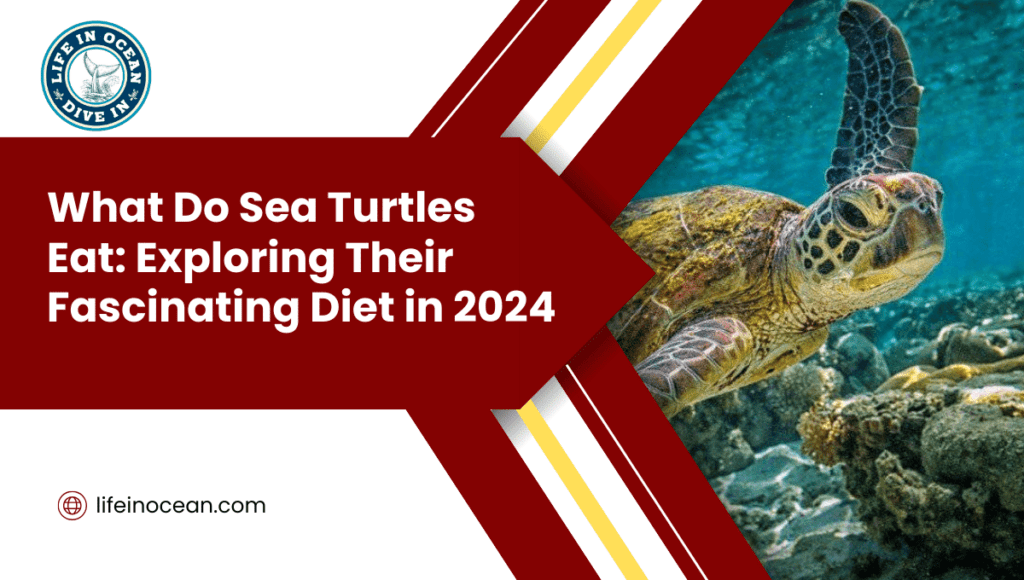
Green sea turtles are known to consume large quantities of seagrass daily, with some estimates suggesting that an adult green sea turtle can eat up to 2 kilograms (4.4 pounds) of seagrass per day. This massive consumption not only shapes the composition and health of the seagrass beds but also influences nutrient cycling within these critical marine habitats.
Conservation Efforts
Conservation efforts aimed at protecting green sea turtles often focus on safeguarding their feeding habitats along coastlines and reducing threats to their populations.
Leatherback Sea Turtle Information
Unique Diet
Leatherback sea turtles have a unique diet that primarily consists of jellyfish. Unlike other sea turtle species, leatherbacks do not have crushing jaws to consume hard-shelled prey. Their specialized diet makes them crucial for the ocean’s ecosystem balance, as they help control jellyfish populations.
These turtles’ preference for jellyfish sometimes leads them to mistake plastic bags and other debris for their prey, which can be fatal. This highlights the importance of conservation efforts to reduce threats such as accidental ingestion of plastic debris.
Specialized Adaptations
As the largest species of sea turtle, leatherbacks have evolved with specialized adaptations for feeding on soft-bodied organisms like jellyfish. Their throats are lined with backward-pointing spines called papillae that prevent slippery prey from escaping.
Moreover, their digestive system is designed to process gelatinous food effectively.
Loggerhead Sea Turtle Information
Diverse Diet
Loggerhead turtles, like other sea turtle species, have a diverse diet. They primarily feed on crustaceans, mollusks, and fish. Their powerful jaws enable them to consume hard-shelled prey such as crabs and conchs. This diverse diet ensures that they obtain the necessary nutrients for their survival and growth.
Loggerhead turtles are known for their ability to adapt to different feeding habits based on their life stage. For instance, juvenile loggerheads often feed on small invertebrates found in seaweed mats or floating debris near the coast. As they mature into adults, they transition to a more carnivorous diet consisting of larger prey items such as horseshoe crabs and whelks.
Conservation Initiatives
Conservation initiatives play a crucial role in protecting loggerhead turtles’ feeding habitats and ensuring the availability of their natural prey sources.
Hawksbill Sea Turtle Information
Specialized Diet
Hawksbill sea turtles have a specialized diet primarily consisting of sponges. Unlike other sea turtle species that have more varied diets, hawksbills are uniquely adapted to feed on sponges found in coral reefs. Their narrow heads and jaws allow them to reach into crevices and extract their preferred food source with ease. This specialized diet helps maintain the balance of the marine ecosystem by preventing sponges from outgrowing and dominating coral reefs.
These sea turtles play a crucial role in maintaining the health of coral reef ecosystems through their feeding habits. By consuming sponges, hawksbill turtles create space for corals and other marine life to thrive within the reef environment. The intricate relationship between these creatures and their habitat underscores the importance of preserving both hawksbill populations and coral reefs.
Olive Ridley Sea Turtle Information
Varied Diet
Olive ridley sea turtles have a varied diet that includes crustaceans, mollusks, and fish. They are opportunistic feeders, meaning they eat whatever is available in their environment. For example, they may consume crabs, shrimp, jellyfish, snails, and small fish.
These turtles play a crucial role in the marine ecosystem by helping to control populations of their prey species. By consuming various marine organisms, they contribute to maintaining the balance within their habitat.
Arribadas Nesting Events
One fascinating behavior exhibited by olive ridley sea turtles is the occurrence of arribadas, where thousands of females come ashore simultaneously to lay eggs. This synchronized nesting event helps ensure the survival of offspring as there’s safety in numbers. It also presents an incredible sight for conservationists and tourists alike.
Kemp Ridley Sea Turtle Information
Opportunistic Feeders
Kemp’s ridley sea turtles are opportunistic feeders, which means they eat a wide variety of prey items. Their diet includes mollusks, jellyfish, shrimp, crabs, and fish. These turtles are known to consume whatever food is available in their environment.
These creatures have adapted to take advantage of different food sources based on what’s accessible at any given time. For example, if there’s an abundance of jellyfish in the area where they forage, Kemp’s ridley sea turtles will feast on them. This adaptability helps them survive in various marine ecosystems.
Conservation Efforts
Kemp’s ridley sea turtles face several threats such as habitat loss and accidental capture in fishing gear. To address these challenges, conservation efforts focus on protecting nesting beaches and implementing turtle excluder devices (TEDs) in fishing nets.
Flatback Sea Turtle Information
Feeding Habits
Flatback sea turtles, unlike other species, primarily feed on soft-bodied invertebrates and jellyfish. Their diet consists of organisms such as sea cucumbers, mollusks, and small fish. This unique feeding behavior sets them apart from other sea turtle species.
These turtles have a restricted distribution in northern Australia and Papua New Guinea. Due to their limited range, conservation initiatives are crucial for understanding their feeding ecology and protecting their nesting sites. By studying their eating habits, conservationists can develop strategies to safeguard the availability of their food sources in these specific regions.
Conservation Efforts
Conservation efforts for flatback sea turtles focus on preserving not only the turtles themselves but also the ecosystems that support their dietary needs. Protecting the habitats where they find soft-bodied invertebrates is essential for ensuring the survival of this distinct species.
Conclusion
So, now you know what sea turtles eat and why it’s crucial for their survival to maintain a healthy diet. From the specific diets of different sea turtle species to feeding guidelines for both wild and pet turtles, understanding their nutritional needs is vital in preserving these magnificent creatures. Whether it’s reducing plastic pollution in oceans or supporting conservation efforts, every small action can make a big difference in ensuring the well-being of sea turtles and their ecosystems.
Next time you’re at the beach, remember the impact of your choices on sea turtle diets and take a moment to appreciate these incredible animals. Consider spreading awareness about the importance of preserving their natural habitats and reducing human-induced threats. Together, we can contribute to creating a safer and healthier environment for sea turtles and all marine life.
Frequently Asked Questions
What are the main components of a sea turtle’s diet?
Sea turtles primarily feed on seagrasses, algae, jellyfish, and invertebrates such as crabs and shrimp. Their specific diet varies by species.
Do sea turtles eat plastic?
Unfortunately, yes. Sea turtles often mistake plastic bags for jellyfish and ingest them, causing serious harm to their digestive systems.
How does the feeding behavior of different sea turtle species vary?
Each species has its own dietary preferences based on factors like habitat and physiology. For example, green turtles are herbivorous while loggerheads have a more varied diet including crustaceans and mollusks.
What should be considered when feeding rescued sea turtles?
Rescued sea turtles require specialized diets tailored to their individual needs. It’s crucial to work with experts or wildlife rehabilitators who understand the nutritional requirements of these animals.

